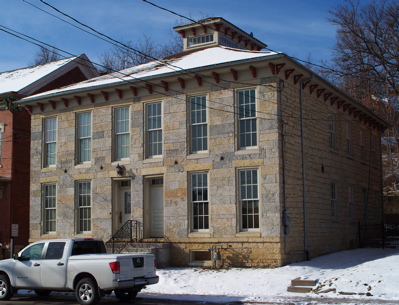Encyclopedia Dubuque
"Encyclopedia Dubuque is the online authority for all things Dubuque, written by the people who know the city best.”
Marshall Cohen—researcher and producer, CNN
Affiliated with the Local History Network of the State Historical Society of Iowa, and the Iowa Museum Association.
STONE ARCHITECTURE: Difference between revisions
No edit summary |
No edit summary |
||
| Line 1: | Line 1: | ||
STONE ARCHITECTURE. Style of construction using native stone quarried from the bluffs. Following the age of log buildings, stone architecture is said to have developed in Cornwall and other parts of Great Britain. It came to Dubuque by way of miners who moved through the Midwest in search of [[LEAD]] and copper. | [[Image:100_0293.jpg|left|thumb|350px|Bluff Street]]STONE ARCHITECTURE. Style of construction using native stone quarried from the bluffs. Following the age of log buildings, stone architecture is said to have developed in Cornwall and other parts of Great Britain. It came to Dubuque by way of miners who moved through the Midwest in search of [[LEAD]] and copper. | ||
Examples of stone buildings have been found along Southern Avenue and West Locust. While the stones were often not carefully cut and fitted, these buildings show the use of native building material. | Examples of stone buildings have been found along Southern Avenue and West Locust. While the stones were often not carefully cut and fitted, these buildings show the use of native building material. | ||
Revision as of 18:28, 28 March 2010
STONE ARCHITECTURE. Style of construction using native stone quarried from the bluffs. Following the age of log buildings, stone architecture is said to have developed in Cornwall and other parts of Great Britain. It came to Dubuque by way of miners who moved through the Midwest in search of LEAD and copper.
Examples of stone buildings have been found along Southern Avenue and West Locust. While the stones were often not carefully cut and fitted, these buildings show the use of native building material.
See: MCMAHON HOUSE


